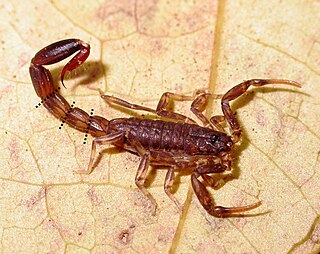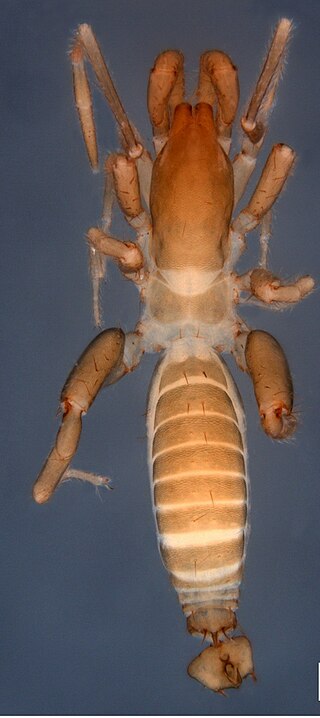
The tawny-crowned greenlet is a species of bird in the family Vireonidae and is the only species placed in the genus Tunchiornis. It is found in Belize, Bolivia, Brazil, Colombia, Costa Rica, Ecuador, French Guiana, Guatemala, Guyana, Honduras, Mexico, Nicaragua, Panama, Peru, Suriname, and Venezuela. Its natural habitat is subtropical or tropical moist lowland forest.
Agoristenidae are a neotropical harvestman family of the Suborder Laniatores, in the superfamily Gonyleptoidea.

Mastigoproctus is a genus of whip scorpions. Native to the tropical forest regions of northern South America, these whip scorpions can reach a length of up to 9 centimetres (3.5 in) and can weigh over 30 grams (1.1 oz). Despite popular belief, they are not venomous as, like all other whip scorpions, they do not possess venom glands.

Ananteris is a little-known genus of rare scorpions. Scorpions belonging to the genus can be found from Costa Rica to Paraguay.

Hubbardiidae is a family of arachnids, superficially resembling spiders. It is the larger of the two extant families of the order, Schizomida, and is divided into two subfamilies. The family is based on the description published by Orator F. Cook in 1899. The American Arachnological Society assigns the common name hubbardiid shorttailed whipscorpion to members of this family.

Glenognatha is a genus of long-jawed orb-weavers that was first described by Eugène Louis Simon in 1887. It was considerably revised in 2016.

Phrynus is a genus of whip spiders found in tropical and subtropical regions, mostly in the new world.

Cryptocellus is an arachnid genus in the order Ricinulei, first described by John Westwood in 1874. It is native to the Neotropics.
Enna is a genus of South American and Central American araneomorph spiders in the family Trechaleidae, first described by Octavius Pickard-Cambridge in 1897.
This is the list of members elected in the 2017 Constituent National Assembly of Venezuela following the 30 July 2017 elections. The first session of the assembly began on 4 August 2017 in the Oval Room of the Palacio Federal Legislativo. The Democratic Unity Roundtable—the opposition to the incumbent ruling party—also boycotted the election claiming that the Constituent Assembly was "a trick to keep [the incumbent ruling party] in power." Since the opposition did not participate in the election, the incumbent Great Patriotic Pole, dominated by the United Socialist Party of Venezuela, won almost all seats in the assembly by default.

Paracharon is a genus of tailless whip scorpion. A single species, Paracharon caecus has been described. It is endemic to Guinea-Bissau in West Africa It is one of two living genera of the family Paracharontidae, alongside the South American Jorottui. It is a troglobite having no eyes, with P. caecus found living in termite nests.

Rowlandius is a genus of hubbardiid short-tailed whipscorpions, first described by Reddell & Cokendolpher in 1995.

Surazomus is a genus of hubbardiid short-tailed whipscorpions, first described by Reddell & Cokendolpher in 1995.
Colombiazomus is a monotypic genus of hubbardiid short-tailed whipscorpions, first described by Armas & Delgado-Santa in 2012. Its single species, Colombiazomustruncatus is distributed in Colombia.
Hansenochrus is a genus of hubbardiid short-tailed whipscorpions, first described by Reddell & Cokendolpher in 1995.
Calima is a genus of hubbardiid short-tailed whipscorpions, first described by Moreno-González & Villarreal in 2012.

Paracharontidae is an arachnid family within the order Amblypygi. Paracharontidae and the extinct Weygoldtinidae from the Carboniferous form the suborder Paleoamblypygi, the sister group to the remaining Amblypygi. The family contains two genera: Paracharon, containing the single species Paracharon caecus Hansen, 1921 from Guinea-Bissau in West Africa, and Jorottui with the single species Jorottui ipuanai from Colombia in northern South America. Paracharonopsis from the Eocene (Ypresian) aged Cambay amber of India was initially assigned to this family but this was later questioned and it has since been reassigned to Euamblypygi. Both living species are troglobites, having no eyes, with P. caecus living in termite nests, while J. ipuanai inhabits caves.









